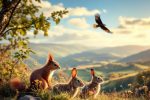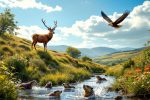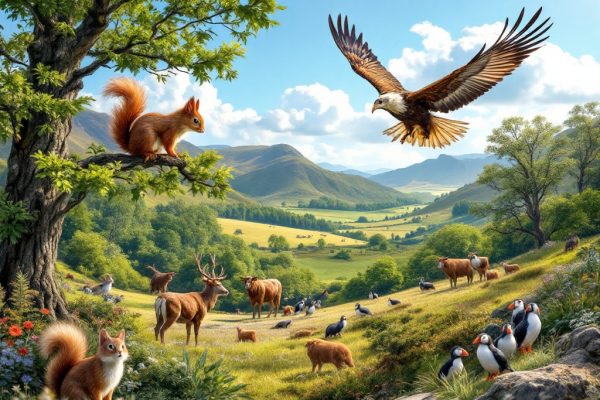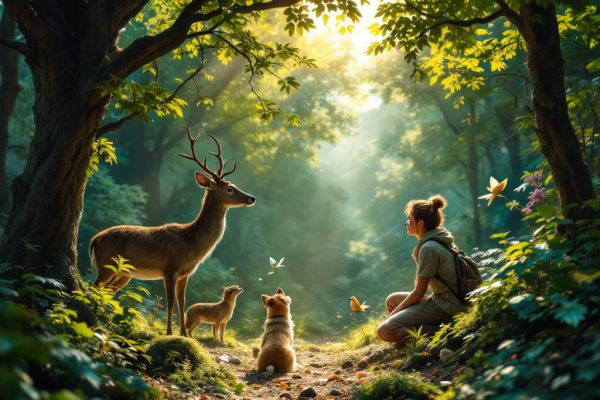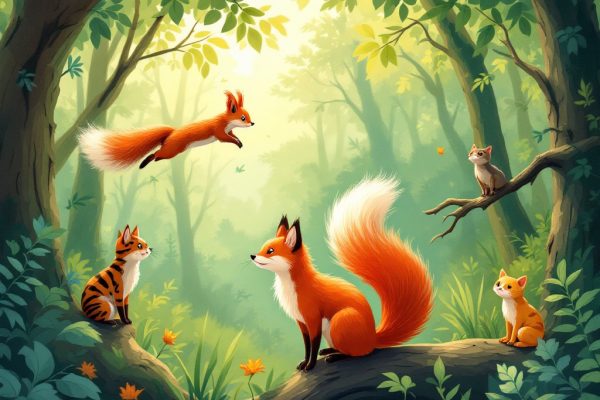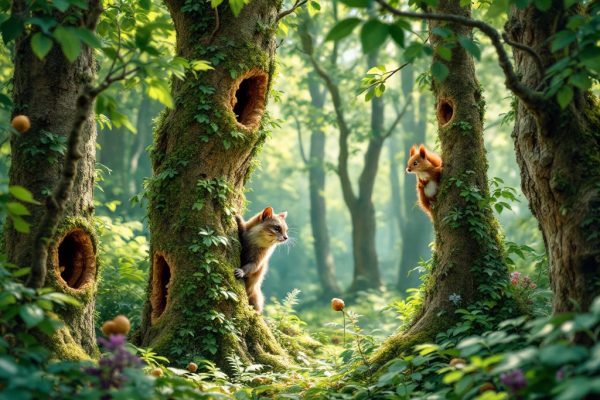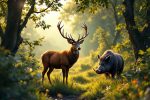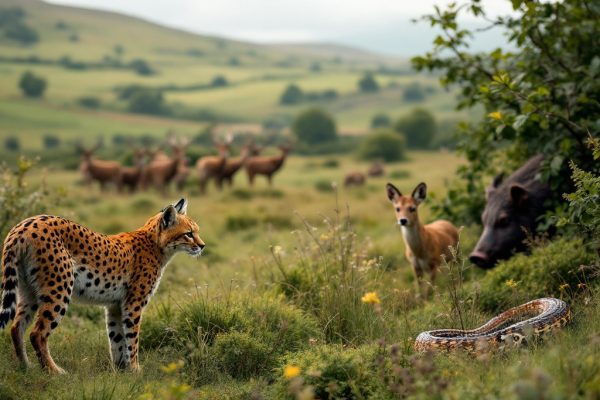What Small Fluffy Wild Animals Can You See in Lothian?
Discover the enchanting world of Lothian’s small, fluffy wildlife! From elusive Scottish wildcats to agile pine martens and the vibrant red squirrel, Lothian’s diverse habitats teem with fascinating creatures. Explore the vital roles these animals play in the local ecosystem, from the badger’s seed dispersal to the hedgehog’s pest control. Learn about the unique adaptations of mountain hares and the impressive speed of brown hares. Delve into the lives of water voles and the impact of beavers on Lothian’s landscape. Uncover the secrets of these charming creatures and deepen your appreciation for Lothian’s rich natural heritage. Start exploring now!
Important information
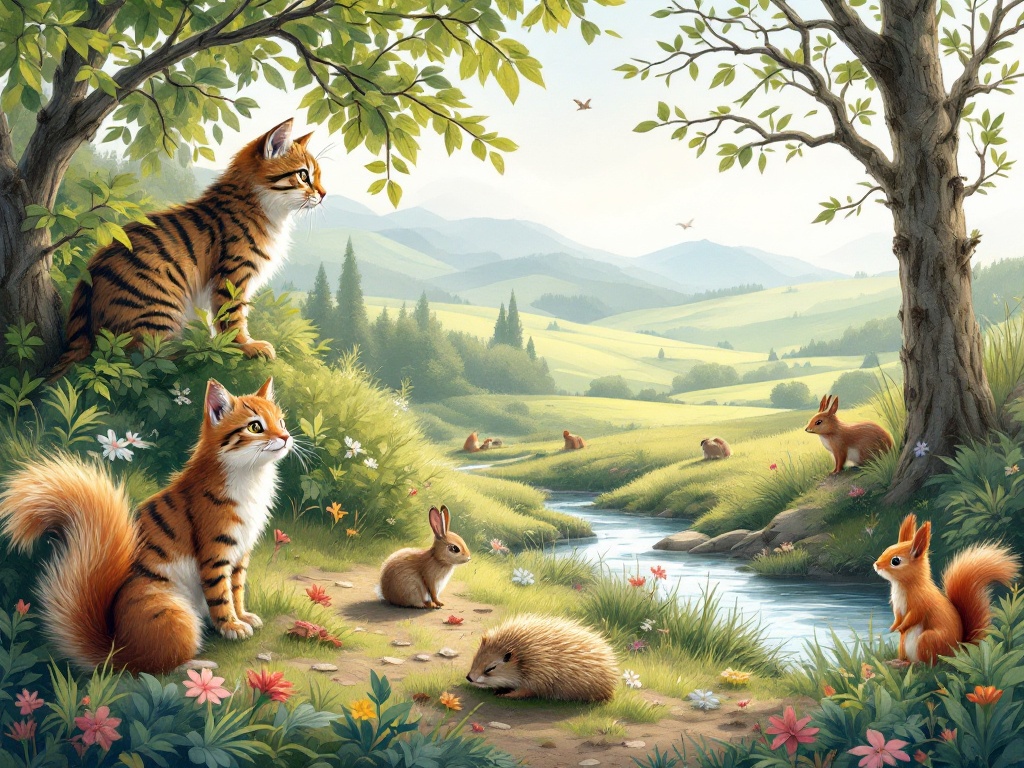
- Lothian has diverse habitats supporting various small, fluffy animals like rabbits, hedgehogs, and rodents.
- Red squirrels, though outnumbered by grey squirrels, are a vital part of Lothian’s fauna and live in coniferous and mixed forests.
- The Scottish wildcat, larger than a house cat, can be found in remote areas and is recognizable by its thick, ringed tail.
- Mountain hares change their fur color seasonally, turning white in winter for camouflage and brownish-grey in summer.
- Eurasian beavers, recently reintroduced, play a crucial role in Lothian’s wetlands by building dams and creating habitats.
Introduction to Small Fluffy Wild Animals in Lothian
Lothian’s diverse habitats, from woodlands and grasslands to urban corners, support a charming array of small, fluffy wildlife. Rabbits, hedgehogs, and various rodents are frequently spotted, highlighting the region’s rich biodiversity. Understanding these species deepens our appreciation for Lothian’s natural heritage.
Water voles inhabit the area’s rivers and wetlands. Red squirrels thrive in coniferous and mixed forests. The elusive Scottish wildcat prefers remote locations.
Brown hares flourish in open fields. Mountain hares seek higher elevations. Lothian also boasts other fascinating furry creatures, such as European rabbits and Eurasian beavers. Keep an eye out, too, for pine martens, stoats, and wood mice.
Understanding Native Species in the Region
Lothian’s ecosystem thrives thanks to its native species. Some of the key inhabitants include:
- the red squirrel, outnumbered by its grey cousin, but still a vital part of the local fauna,
- the water vole, Europe’s largest native species of its kind,
- the pine marten, further enriching Lothian’s biodiversity.
Importance of Woodland Habitats for Fluffy Mammals
Lothian’s woodlands are essential for the survival of many furry creatures. These forests offer refuge from predators such as foxes and hawks, and provide a rich variety of food. This includes berries, nuts, insects, and small animals. The woods also serve as important breeding grounds, offering safe havens for raising young. For instance, badgers dig protective burrows, while hedgehogs nestle amongst leaves and undergrowth. Agile pine martens utilize the trees for both nesting and hunting.
Role of Habitats for Species like Hedgehog and Badger
Lothian’s woodlands provide essential habitat for hedgehogs and badgers. Hedgehogs, natural pest controllers, primarily consume insects. Badgers, with their omnivorous diet, play a key role in seed dispersal. Both animals find shelter and food within these woodlands, contributing to the ecosystem’s overall health.
Exploring Woodland Habitats: Pine Martens and More
Agile pine martens, elusive woodland creatures, play a key role in the forest ecosystem. Stoats, with their long, slender bodies perfectly adapted for hunting small mammals and birds, also inhabit these woodlands. Though rare, wildcats still roam some Scottish forests. Abundant wood mice form a vital food source for many predators in this habitat.
Pine Martens in Their Natural Environment
Lothian’s woodlands provide a haven for the elusive pine marten, a vital predator that helps maintain a balanced ecosystem by controlling populations of prey such as voles and squirrels.
Woodland Inhabitants: Stoat, Wildcat, and Wood Mouse
Lothian woodlands teem with fascinating creatures, such as stoats, wildcats, and wood mice. The stoat, a small but fierce predator, plays a vital role in the ecosystem. With its long, slender body and short legs, it’s a formidable hunter. Wood mice, small rodents with large ears and eyes, are equally important. These creatures play a crucial role in seed dispersal, contributing to the woodland’s overall health. And, if you’re incredibly lucky, you might catch a glimpse of the elusive Scottish wildcat. Larger than a house cat, this wild feline is distinguished by its thick, ringed tail.
Spotting the Elusive Red Squirrel
Recognizable by their vibrant red fur, tufted ears, and bushy tails, red squirrels are small, arboreal rodents. These agile creatures measure 30 to 40 cm long, including their impressive 15 to 20 cm tail, and weigh between 250 and 340 grams. A distinguishing feature of the red squirrel is the lengthening of their ear tufts during winter.
Inhabiting coniferous and mixed forests, red squirrels are diurnal, constantly foraging for sustenance. Their diet primarily consists of seeds and nuts, supplemented by fruits, fungi, and occasionally insects and bird eggs. For shelter and raising their young, they construct spherical nests, known as dreys, high in the trees, using twigs, leaves, and moss.
Characteristics of the Red Squirrel
Red squirrels are small, tree-dwelling mammals recognizable by their reddish-brown fur, tufted ears, and bushy tails. These agile creatures measure 30 to 40 cm long and weigh between 250 and 350 grams. Their vibrant coat provides excellent camouflage amongst the trees. Active by day, they forage for a varied diet of seeds, nuts, fruits, and fungi, contributing significantly to seed dispersal and forest regeneration.
Habitats and Behaviors
Red squirrels thrive in coniferous and mixed forests, fiercely protecting their territories. These diurnal creatures, active during daylight hours, inject a vibrant energy into the forest ecosystem. Their agility is exceptional, using sharp claws and bushy tails for balance as they gracefully leap between trees. Conifer seeds are their primary food source, supplemented by nuts, fungi, and fruits. High in the canopy, they build spherical nests known as dreys, providing safe havens for raising their young and shelter from predators and harsh weather.
Discovering the Scottish Wildcat
The Scottish wildcat (Felis silvestris silvestris) sports a thick, tabby-striped coat and a bushy tail with a distinctive black tip. It’s also significantly larger and more powerfully built than the average house cat.
Appearance and Distinctive Features
The Scottish Wildcat is easily recognized by its thick, bushy tail with distinctive black rings and dark stripes across its body. This natural camouflage helps it blend into woodland and grassland habitats. A powerful build and sharp claws make it a formidable hunter, primarily of rabbits and rodents. Occasionally, it can take down larger prey thanks to its robust physique.
The Secretive Water Vole
The European water vole, Europe’s largest native vole, is a shy creature inhabiting areas near rivers, streams, ditches, and ponds. Its presence plays a vital role in the health of these ecosystems.
Understanding Their Habitats
Water voles thrive in various wetland environments, including rivers, streams, ditches, and dykes. These locations offer plentiful vegetation, which serves as both a food source and a material for burrowing. The presence of water voles signifies a healthy ecosystem. Their burrows strengthen riverbanks and offer shelter to other small creatures, establishing them as a keystone species.
Spotting Brown and Mountain Hares
Brown hares thrive in open fields, displaying impressive speed and agility. Their coat color remains constant throughout the year.
Mountain hares, conversely, adapt to the changing seasons by changing their fur color. They turn white in winter to blend in with the snowy, hilly landscapes, such as those found in Lothian. This seasonal change is crucial for their survival.
Brown Hare: A Field Sprinter
Brown hares are remarkably swift, reaching speeds of up to 45 mph in open fields, enabling them to evade predators like foxes and eagles. Larger than rabbits, they possess longer legs and distinctive black-tipped ears. Throughout Lothian, these hares primarily inhabit open fields and farmland.
Mountain Hare: Adapting to the Seasons
Mountain hares are masters of camouflage, their fur changing color with the seasons. In winter, their white coat allows them to blend seamlessly with the snow, providing excellent camouflage from predators like foxes and eagles.
When summer arrives, their fur shifts to a brownish-gray, allowing them to blend in with rocks and vegetation. This seasonal adaptation is crucial for their survival.
Other Notable Wildlife in Lothian
Lothian’s diverse wildlife includes the European Rabbit and the Eurasian Beaver. European Rabbits, through their burrowing activities, have a substantial impact on the local plant life. Eurasian Beavers, known for their dam-building, significantly alter watercourses and create vital wetland habitats. Their presence dramatically reshapes the landscape.
European Rabbit and Eurasian Beaver
European Rabbits are a common sight across Lothian, but Eurasian Beavers, recently reintroduced, are less frequently observed. These beavers now play a crucial role in the health of Lothian’s wetlands. Their dam-building activities create vital habitats and improve water quality.


